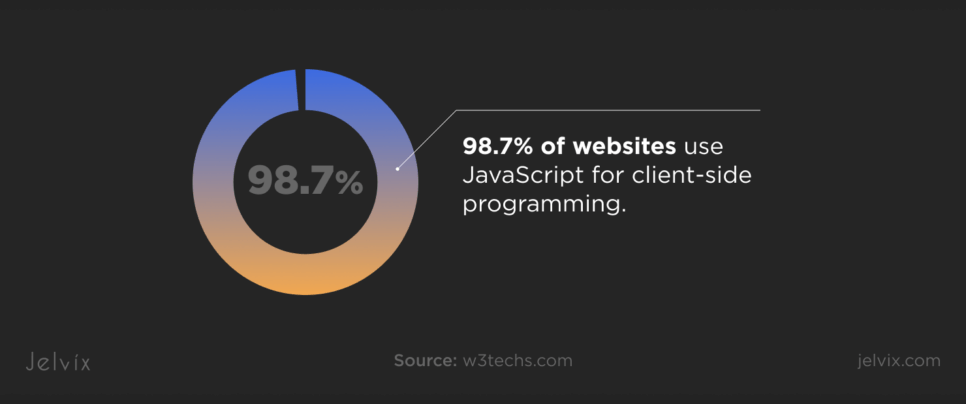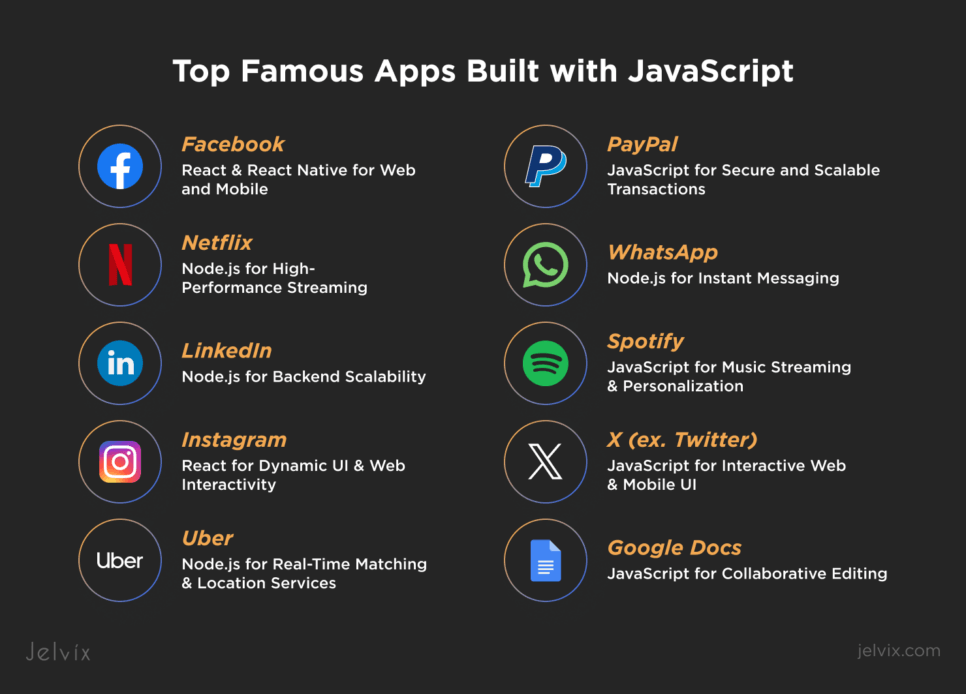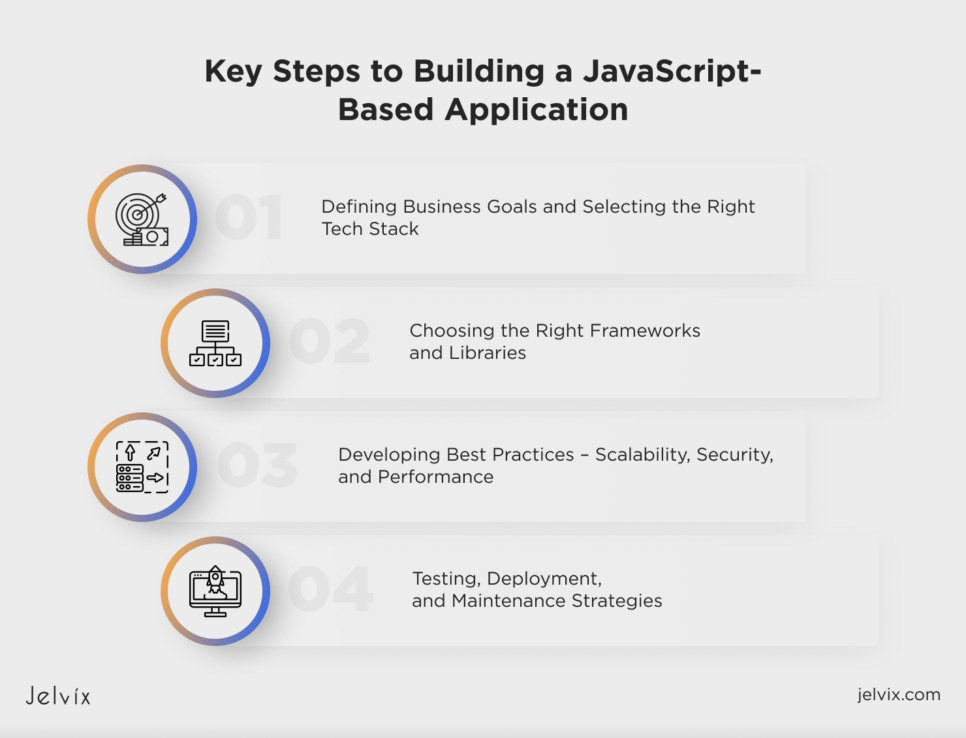JavaScript is everywhere, from the web pages you visit to the daily apps you use. Originally meant to bring interaction to webpages, today, it is the most often used programming language available worldwide. JavaScript app development drives everything from social networking platforms and e-commerce sites to real-time chat apps and corporate software.
The figures speak for themselves:
- 98.7% of websites use JavaScript for client-side programming;
- 2.1% of all websites run with Node.js alone, which lets JavaScript operate on servers;
- over 17.5 million developers regularly use JavaScript, making it the most popular language worldwide;
- the JavaScript ecosystem contains over 2.1 million npm packages, hence driving fast development across sectors.
JavaScript is, however, not only about the web; it plays a major role in mobile and cross-platform app development. Companies can create high-performance apps for iOS, Android, and desktops without changing languages using React Native and Electron frameworks.
The following article reviews well-known JavaScript apps developed by industry experts. These apps use their capabilities to produce flawless, scalable, and creative digital experiences.
Why Choose JavaScript for App Development?
JavaScript has become the go-to language for building web, mobile, and desktop applications. Its ability to run on both frontend and backend, combined with a massive ecosystem of frameworks and libraries, makes it one of the most versatile programming languages in the world. JavaScript app development provides speed, adaptability, and a reasonably priced solution whether your company needs scalability or a startup ready for a speedy launch.
Advantages of JavaScript for Mobile App Development
Cross-Platform Development
Using React Native and Ionic, developers can create one JavaScript app that runs on both Android and iOS. This eliminates the need to create distinct native apps, saving time and money.
Faster Development & Lower Costs
JavaScript’s extensive library ecosystem speeds up development. Instead of building everything from scratch, developers can leverage pre-built components and third-party integrations.
- React Native and other JavaScript frameworks let developers reuse up to 90% of the code across platforms;
- Frontend and backend handling by one JavaScript team helps to lower development expenses.
Seamless Updates & Dynamic Content
Real-time updates for JavaScript mobile apps free users from having to download new versions. This lets businesses immediately push UI upgrades, feature enhancements, and issue fixes.
Extensive Community & Ecosystem
With over 17.5 million developers, JavaScript has one of the largest programming communities. This means:
- Faster Troubleshooting: Developers can find solutions quickly;
- Continuous Innovation: New tools and updates keep JavaScript ahead;
- Long-term Support: The ecosystem is constantly evolving, ensuring longevity.
Performance & Scalability
Modern JavaScript engines like Google’s V8 (used in Chrome and Node.js) have made JavaScript apps blazing fast. Combined with frameworks like Electron (for desktop apps) and React Native (for mobile apps), JavaScript provides native-like performance with scalability for millions of users.
JavaScript Frameworks: Powering Mobile App Development
JavaScript frameworks offer easily available tools and templates meant to streamline development. These frameworks include built-in solutions for:
- AJAX requests and event handling;
- Real-time updates;
- UI animations and transitions;
- Data manipulation and storage.
For this reason, businesses—from startups to tech behemoths—rely on JavaScript for mobile app development. JavaScript powers Facebook, Instagram, WhatsApp, Airbnb, and other apps.
Types of Software That Can Be Built with JavaScript
JavaScript’s flexibility transcends simple web pages. Today, it drives everything from interactive online apps to enterprise-grade cloud-based platforms. Developers can use appropriate frameworks and tools to create high-performance apps across several platforms, including web, mobile, server-side, and even AI-powered systems.
Let us dissect the main categories of software JavaScript makes possible.
Web Applications
JavaScript is the foundation of modern web app development, enabling dynamic, fast, and user-friendly experiences.
Single Page Applications (SPAs):
SPAs load a single HTML page and update content dynamically without requiring complete page reloads. Their flawless navigation depends on JavaScript frameworks such as React, Angular, and Vue.js.
Progressive Web Apps (PWAs):
PWAs bring native app-like functionality to the web. They load instantly, run offline, and may be installed on mobile devices without an app store.
Real-Time Web Applications:
Developers may use WebSockets and JavaScript-powered backends to construct real-time features, such as live chats, alerts, and collaborative tools.
Mobile Applications
JavaScript is not only for the web; it is also a major contributor to the creation of mobile apps. It allows developers to build native-quality apps with a single codebase.
React Native (by Meta):
React Native enables developers to create fully native iOS and Android apps using JavaScript. It preserves almost native performance while enabling code reuse between platforms.
Ionic & Cordova:
Ionic lets JavaScript developers, housed inside a native container, create hybrid mobile apps utilizing HTML, CSS, and JavaScript.
Node.js for Backend Services:
Many mobile apps also use JavaScript on the backend. Node.js enables fast, scalable APIs for mobile apps that need real-time capabilities.
Server-Side Applications
Node.js lets JavaScript run on servers, effectively handling backend functionality, databases, and APIs.
Scalable, Non-Blocking Servers:
For heavy traffic applications, Node.js is perfect since it employs an event-driven, non-blocking I/O approach.
Microservices & RESTful APIs:
Scalable microservices powered by JavaScript are increasingly developed using RESTful APIs. These support major apps.
Serverless & Cloud Functions:
With platforms like AWS Lambda and Firebase Functions, developers can deploy serverless applications using JavaScript.
Enterprise Software & Cloud Solutions
Many big companies depend on JavaScript for cloud-based systems and enterprise apps.
Enterprise Resource Planning (ERP) & CRM Systems:
Strong dashboard-driven enterprise apps are created in part by JavaScript frameworks, including Angular and React.
Big Data & Analytics Dashboards:
D3.js, Chart.js, and other JavaScript tools enable real-time visualizing of intricate information.
Cloud-Based Collaboration Tools:
JavaScript powers real-time collaboration in such apps as Slack, Google Drive, and Notion.
AI-Powered & Real-Time Applications
As machine learning and artificial intelligence grow, JavaScript is being used to construct intelligent apps that process and evaluate data in real time.
Machine Learning with TensorFlow.js:
JavaScript can train and run ML models straight on the server or in the browser with TensorFlow.js.
Chatbots & AI Assistants:
Using frameworks like BotPress and Dialogflow, developers build AI-powered chatbots with JavaScript.
IoT & Smart Devices:
JavaScript (via Node.js) enables communication between IoT devices, processing real-time data.
JavaScript is widely used for everything from real-time web apps to AI-powered solutions. It is a top choice for quick, scalable, and reasonably priced development across organizations because it lets companies write once and deploy anywhere. Businesses no longer have to create separate apps for multiple platforms; one JavaScript codebase may run web, mobile, and even desktop apps with few tweaks.
Most Popular JavaScript Frameworks and Libraries
We have already mentioned JavaScript’s great strength, which is derived from the language and its vast framework and library ecosystem. These tools enable developers to create scalable, high-performance JavaScript applications across many platforms, including web, mobile, backend, and full-stack solutions.
Below, we’ll break down the most popular JavaScript frameworks, why they are widely adopted, and how businesses use them to create famous apps that millions rely on daily.
Frontend Frameworks: Enhancing User Experience
Frontend systems simplify user interface (UI) development, facilitating the creation of interactive and dynamic web applications.
Designed by Meta (Facebook), React.js is a component-based JavaScript tool that lets developers quickly create reusable UIs. It maximizes rendering performance through a virtual DOM, minimizing pointless re-rendering and accelerating application speed. React’s component-driven design guarantees improved maintainability and scalability, making it quite modular. Companies choose React.js because of its rapid rendering, broad third-party support, and smooth server-side rendering (SSR) integration with Next.js.
Conversely, Vue.js is a wonderful choice for small to medium-sized projects because of its simplicity and adaptability. Its component-based approach and reactive data binding allow for easy and effective development. Companies that want quick application development using a lightweight framework especially find Vue.js a good choice.
Google developed Angular, a TypeScript-based framework designed for enterprise-scale applications requiring a structured and maintainable architecture. Unlike React and Vue, Angular is a complete framework with built-in solutions for dependency injection, routing, and state management. For uses requiring continuous data synchronization, its two-way data binding ensures real-time updates between the model and the display.
Backend Frameworks: Powering Scalability and Performance
JavaScript is no longer just a frontend technology; with Node.js, it has become a dominant force in backend development. Node.js is a server-side runtime environment that allows developers to run JavaScript on the backend, creating high-performance and scalable applications. Operating on an event-driven, non-blocking design, it is perfect for managing several concurrent connections with low latency. This architecture lets businesses create real-time products like cloud-based tools, streaming services, and chat platforms. Thanks in great part to the V8 JavaScript engine, which converts JavaScript into highly efficient machine code, Node.js mobile apps are known for their speed and efficiency.
Express.js is among the most often used tools for building backend APIs. This lightweight, unopinionated web application framework simplifies server-side development by providing strong capabilities for managing HTTP inquiries, authentication, and middleware integration. The dDevelopment of RESTful APIs makes extensive use of Express.js, therefore enabling companies to produce stable and scalable solutions.
NestJS has become well-known as a flexible and scalable backend system for more complex, enterprise-grade apps. Designed atop Node.js and TypeScript, it offers a structured approach to backend development with built-in GraphQL, WebSockets, and microservices architectural support. Given its great scalability and maintainability, NestJs are preferred for large-scale corporate systems demanding effective module-based architecture and structured dependency injection.
Mobile Frameworks: JavaScript for Cross-Platform Apps
Meta’s React Native allows developers to share much of the code between platforms while building completely native mobile apps for iOS and Android. It uses native UI components instead of hybrid frameworks, producing almost native performance without sacrificing flexibility. React Native’s cost-efficiency, quick development cycles, and excellent community support appeal to businesses.
Another JavaScript-based framework enabling developers to construct hybrid mobile apps combining HTML, CSS, and JavaScript is Ionic. Whereas React Native collects native code, Ionic runs apps inside a browser environment wrapped in a native container using WebView. For Progressive Web Apps (PWAs) and mobile apps devoid of complete native performance, Ionic is thus a great solution.
Full-Stack JavaScript: The Complete Development Solution
Full-stack JavaScript development streamlines the development process and lowers running costs by allowing businesses to utilize one language across the whole stack.
One of the most often used full-stack solutions, the MERN stack (MongoDB, Express.js, React, Node.js), lets developers create scalable JavaScript applications with a fully integrated architecture. This architecture is extensively used by SPAs and real-time web apps that need a flawless link between the front- and backend. Though it uses Vue.js for front-end development, the MEVN (MongoDB, Express.js, Node.js) stack presents a similar structure and is, therefore, perfect for lightweight and dynamic apps.
Because of Angular’s built-in scalability characteristics, the MEAN stack (MongoDB, Express.js, Angular, Node.js) is a preferred choice for corporate applications. Companies use this stack to develop data-driven applications requiring a structured architecture with thorough dependability management. Full-stack JavaScript solutions are a favorite choice for both startups and large-scale businesses since they allow GraphQL, WebSockets, and cloud services to be combined.
Top Famous Apps Built with JavaScript
Modern app development is mainly based on JavaScript, which powers some of the most frequently used programs worldwide. From social networking behemoths to streaming services, businesses use JavaScript to produce quick, engaging, scalable apps for web and mobile platforms. JavaScript application development shapes the digital terrain via frontend frameworks like React and Angular, backend solutions like Node.js, or cross-platform mobile frameworks like React Native.
What companies use Javascript, though, and how do they use it in their programs? Let’s investigate ten of the most well-known JavaScript programs and their uses of JavaScript capabilities.
Facebook – React & React Native for Web and Mobile
One of the most used social media sites worldwide, Facebook, mostly depends on JavaScript to provide a flawless user experience. Initially developing React.js to manage the intricate UI modifications required for its interactive web platform, this company’s virtual DOM guarantees a seamless and responsive user experience by letting Facebook’s interface dynamically adapt without reloading the whole page. React Native drives Facebook’s iOS and Android mobile apps, enabling shared code between platforms, lowering development time, and enhancing performance.
Netflix – Node.js for High-Performance Streaming
Netflix is the world’s most significant streaming service. Its backend uses Node.js to manage enormous volumes of real-time data and guarantee seamless video playback. With more than 260 million members, Netflix requires a mechanism that can effectively handle concurrent user requests, maximize content delivery, and lower latency.
Switching to Node.js helped Netflix increase performance by cutting startup times by seventy percent. Node.js’s event-driven, non-blocking architecture lets Netflix effectively present content even during high traffic. This explains why businesses employ JavaScript—it offers the scalability and performance needed for worldwide applications.
LinkedIn – Node.js for Backend Scalability
LinkedIn, the biggest professional networking site worldwide, strategically moved to Node.js to enhance user interactions and server efficiency. Originally Ruby on Rails, LinkedIn discovered that Node.js lowered server response time by 35%, facilitating faster and more scalable data handling.
LinkedIn’s infrastructure must rapidly handle real-time updates, notifications, and search requests from over 900 million users. Node.js guarantees instantaneous user activities, such as messaging or profile updating, thereby enabling a single-threaded, non-blocking method.
Instagram – React for Dynamic UI & Web Interactivity
Instagram, one of the most engaging social media apps, relies on JavaScript with React.js for front-end development. Instagram’s UI calls for a very effective rendering engine with elements like unlimited scrolling, real-time updates, and flawless photo uploads.
React’s virtual DOM updates only changed elements, lowering lag and increasing UI responsiveness. This makes user interactions—like liking posts, leaving comments, and flipping between stories—feel quick. JavaScript’s component-based architecture also enables Instagram’s development team to reuse UI elements between the web and mobile versions, ensuring consistency.
Uber – Node.js for Real-Time Matching & Location Services
Uber, the ride-hailing behemoth, runs its real-time matching system, which links users with drivers, on Node.js. The company processes millions of ride requests every second, so it needs a dependable, quick, and scalable backend.
It is the ideal tool because Node.js’s asynchronous event loop allows Uber to handle real-time GPS data, ride requests, and pricing computations without delay. Furthermore, JavaScript enables WebSockets and instantaneous communication between drivers and passengers.
PayPal – JavaScript for Secure and Scalable Transactions
Leading online payment provider PayPal turned to Node.js to increase server-side speed and performance. Originally developed on Java, PayPal discovered that Node.js allowed it to process twice as many requests per second while cutting response times.
The backend, driven by JavaScript, handles millions of safe transactions daily and perfectly interfaces with web and mobile systems. The company also uses React.js for an optimal frontend experience, guaranteeing quick page loading and easy navigation.
WhatsApp – Node.js for Instant Messaging
Among the most frequently utilized messaging apps, WhatsApp uses Node.js and JavaScript to manage its real-time messaging system. The backend of the app handles billions of messages every day and calls for a low-latency, very concurrent architecture.
The asynchronous design of Node.js lets WhatsApp provide end-to-end encryption across platforms, push notifications, and instant message synchronizing capability. This is another reason companies use JavaScript, as it provides the necessary scalability for large-scale communication platforms.
Spotify – JavaScript for Music Streaming & Personalization
Spotify is a global leader in music streaming. To improve user experience, Spotify combines JavaScript on the frontend and backend. The company’s web interface, React.js, ensures quick rendering of music libraries and tailored recommendations.
Node.js runs artificial intelligence-driven content recommendations, collaborative playlists, and real-time song playback on the backend. JavaScript’s adaptability allows Spotify to easily include user-generated playlists, third-party APIs, and real-time streaming without performance issues.
X (ex. Twitter) – JavaScript for Interactive Web & Mobile UI
React.js and Node.js JavaScript frameworks help X’s online and mobile platforms manage high tweet traffic, trends, and live updates. React provides fast-rendering feeds, real-time notifications, and UI animations for the company’s frontend.
Node.js provides scalable API tools and real-time tweeting capability on the backend. X uses JavaScript to guarantee that tweets, retweets, likes, and hashtags update in real time without users having to refresh their screens.
Google Docs – JavaScript for Collaborative Editing
One great example of how JavaScript allows real-time collaboration is Google Docs. The program lets several people edit the same document simultaneously using JavaScript-powered WebSockets. This real-time syncing guarantees that modifications made by one user immediately appear for others without any delay.
Google Docs also uses Firebase—which supports JavaScript—for backend synchronization and React.js for UI updates. This combo allows live chat integration, instant saves, and flawless document editing within the platform.
These ten well-known examples of applications show how JavaScript development helps companies produce scalable, high-performance programs over the web and mobile platforms. From real-time services like Uber and WhatsApp to social networking giants like Facebook and Instagram, JavaScript is a vital tool for creating modern digital experiences.
Nearly every big software business depends on it for its speed, scalability, and cross-platform capability, so the answer to who uses JavaScript and why is obvious. The ongoing development of Node.js, React, and other JavaScript frameworks will help the language remain a major player in software development for many years to come.
Key Steps to Building a JavaScript-Based Application
Step 1: Defining Business Goals and Selecting the Right Tech Stack
Defining the application’s business goals is essential before developing one line of code. Knowing what the app needs to do, who its target users are, and which platforms it will operate on will affect its technological stack and development strategy.
From single-page applications (SPAs) and progressive web apps (PWAs) to complete-stack enterprise solutions, JavaScript is extensively employed across many kinds of applications. For what purpose is JavaScript used in this context?
Step 2: Choosing the Right Frameworks and Libraries
Choosing the correct JavaScript tools becomes crucial once the company goals are established:
- Frontend for dynamic user interfaces: React.js, Vue.js, or Angular;
- Backend: Node.js for server-side logic either with Express.js or NestJs;
- Usually linked with JavaScript-based ORMs like Sequelize, databases include MongoDB (NoSQL) or Postgres (SQL);
- React Native or Ionic for cross-platform JavaScript mobile apps.
Every one of these technologies is selected depending on performance criteria, scalability needs, and project complexity.
Step 3: Developing Best Practices – Scalability, Security, and Performance
Building a robust JavaScript application requires adherence to best practices in architecture, security, and optimization.
Scalability Considerations:
- Modular Code Structure: Applications that use a component-based approach, such as React, Angular, or Vue, can scale efficiently;
- Server-Side Load Balancing: Implementing Node.js clusters and load balancers ensures high availability under heavy traffic;
- Microservices Architecture: Instead of a monolithic approach, NestJS or Express.js with Kubernetes can break applications into scalable microservices.
Security Best Practices:
- Cross-Site Scripting (XSS) Protection: Avoid inserting user-generated content into the DOM directly. Libraries like DOMPurify sanitize input;
- Prevent SQL Injection: Use parameterized queries with ORMs like Sequelize or Mongoose;
- Authentication & Authorization: Implement JWT (JSON Web Tokens) and OAuth2 for secure user authentication;
- Secure APIs: Stop unwanted access via HTTPS, CORS restrictions, and API rate limits.
Performance Optimization:
- Lazy Loading and Code Splitting: In React and Angular, this helps to reduce loading pointless resources, hence lowering first page load times;
- Server-Side Rendering (SSR): Next.js (React) and Nuxt.js (Vue) improve performance and SEO by rendering pages on the server;
- Optimized Database Queries: Use indexed searches in MongoDB and Postgres to expedite data access in optimized database queries;
- Efficient Caching Strategies: Implement Redis or Memcached to reduce database load and enhance app performance.
Following these best practices ensures highly secure, scalable, and fast JavaScript applications that can handle millions of users without performance bottlenecks.
Step 4: Testing, Deployment, and Maintenance Strategies
A well-developed application is incomplete without thorough testing, deployment automation, and ongoing maintenance.
JavaScript applications must be tested entirely with unit, integration, and end-to-end (E2E) testing:
- Jest and Mocha will test separate components and functions in unit testing.
- Supertest and Chai can help to confirm API interactions.
- Cypress and Selenium are good choices for browser-based UI E2E testing.
- Automated testing helps catch bugs early, ensuring a seamless user experience before deployment.
Once an application passes tests, it has to be put to use effectively.
- Continuous Integration/Continuous Deployment (CI/CD): Tools like GitHub Actions, Jenkins, and CircleCI automate the deployment process.
- Cloud Hosting: Platforms like AWS, Google Cloud, and Vercel offer scalable hosting for JavaScript applications.
- Containerization: Docker and Kubernetes are widely used to deploy scalable microservices architectures.
Applications require continuous monitoring and updates to keep up with security patches, performance improvements, and feature enhancements.
- Error Monitoring: Tools like Sentry and LogRocket track errors and crashes in real time.
- Performance Monitoring: Services like New Relic and Google Lighthouse analyze app performance and provide optimization insights.
- Feature Releases: LaunchDarkly’s A/B testing aids in controlled feature releases.
- Strong testing and deployment pipelines help companies make sure their JavaScript apps stay dependable, safe, and current.
Businesses implement a robust testing and deployment pipeline to ensure that their JavaScript applications remain reliable, secure, and up to date.
Learn more about the main stages of application development lifecycle to build a sustainable product.
Conclusion
JavaScript’s extensive use cases let companies create everything from scalable e-commerce systems to real-time financial dashboards driven by artificial intelligence. For what purposes does JavaScript find application in the modern development scene? From frontend interfaces, backend servers and cross-platform mobile apps to even machine learning-powered solutions–almost everything.
React, Vue, Angular, and Node.js are helping to shape scalable, high-performance apps as JavaScript develops. Using these strict development steps and best practices guarantees effective project execution, whether creating a cloud-based enterprise solution or a JavaScript mobile app.
Creating a high-speed JavaScript application calls for choosing the appropriate technological stack, using scalable architectures, enhancing security, and guaranteeing seamless performance across devices, not only for coding. At Jelvix, we specialize in JavaScript application development, helping businesses create scalable, secure, and high-performance solutions tailored to their unique requirements.
Our experience covers the whole JavaScript ecosystem, from front-end interfaces and backend systems to cross-platform mobile apps. Whether your project is a JavaScript mobile app, an enterprise-grade SaaS product, a real-time online application, or another, we provide end-to-end development services meant to maximize scalability, performance, and efficiency. Contact Jelvix today to explore how we will elevate your business.
FAQ
How does JavaScript contribute to business growth?
JavaScript lets companies create dynamic, scalable, speedy apps that increase user involvement and customer retention. Its adaptability for online, mobile, and backend development helps to speed up time to market and lower costs.
What are the security challenges of JavaScript applications?
Common security issues include data disclosure, code injection, and cross-site scripting (XSS). Developers can reduce such challenges by applying best practices, such as security audits, frequent upgrades, and safe coding.
What industries benefit the most from JavaScript development?
Industries including financial, e-commerce, healthcare, and entertainment employ JavaScript to create dynamic, real-time apps with flawless user experiences.
Why do enterprises rely on Node.js for backend development?
Companies choose Node.js because of its non-blocking, event-driven architecture that guarantees scalability and great speed.
How can businesses ensure the long-term scalability of JavaScript applications?
Companies may create scalable JavaScript apps that fit expansion by using a modular architecture, cloud-based infrastructure, and the best coding standards.
Need a qualified team of developers?
Own the dedicated development team of professionals exclusively for your project.













